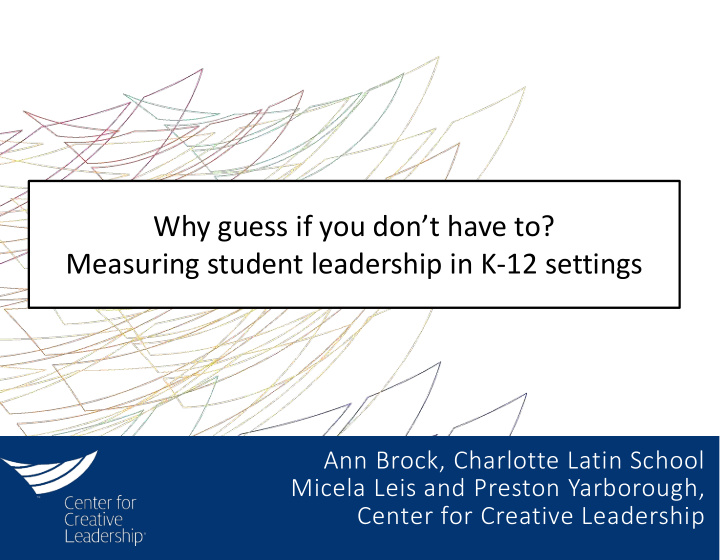



Why guess if you don’t have to? Measuring student leadership in K-12 settings Ann Brock, Charlotte Latin School Micela Leis and Preston Yarborough, Center for Creative Leadership
Ann Brock Director of Leadership Development Charlotte Latin School abrock01@charlottelatin.org Preston Yarborough Micela Leis Senior Faculty Research Scientist Center for Creative Leadership Center for Creative Leadership yarboroughp@ccl.org leism@ccl.org
At what age should youth leadership development begin? 90% of respondents believed it should begin before age 18. 90% said before age 18 Van Velsor, E. & Wright, J. (2012) Expanding the Leadership Equation [White paper]. Center for Creative Leadership.
Should all youth have access to leadership development? 84% of respondents believed leadership development should 84% said ALL youth should have access be available to all youth. Van Velsor, E. & Wright, J. (2012) Expanding the Leadership Equation [White paper]. Center for Creative Leadership.
Charlotte Latin’s Relationship with Youth Leadership Development CLS determined that student leadership development would be an important part of our strategic planning process. A few essential questions remained: How do we as a school community define leadership? How do we make it accessible to all students?
Development of the Student Leadership Scale Open Ended Questionnaire 1,067 youth from 1 school Thematic Coding Scale Writing Scale Pilot 923 youth from 3 schools Factor Example Item: Analysis 7,914 youth from 35 schools
Student Leadership Framework Values School Self-Aware Integrity Participative Leading Self Leading Academically Accountable Attentive Deep Belief that learning is Resilient understanding important and valuable of yourself and your own behavior Accepting Changing Your World Working to Respectful Leading with Others Visionary make a positive Considerate Working effectively impact in Your Motivating with others Active world (acts as a Listener change agent) Confident Communicative Encouraging Collaborative
Leadership Framework Attributes Leading Self Leading Academically Changing Your World Leading With Others
Leadership Framework Attributes Dimensions Attributes Definitions Leading Self Can describe what makes them who they are. Self-Aware Leading Self Takes responsibility for their actions. Accountable Leading Self Keeps trying if they fail at an important goal. Resilient Leading Self Stands up for what they believe in. Integrity Leading Academically Values School Thinks it is important to do well in school. Leading Academically Participative Participates in class discussions. Leading Academically Attentive Pays attention when the teacher is speaking. Leading with Others Cooperates with others effectively. Collaborative Expresses ideas clearly and effectively (including giving and Communicative Leading with Others receiving feedback). Leading with Others Listens carefully to what others have to say. Active Listener Leading with Others Thinks about how their actions make other people feel. Considerate Leading with Others Treats other people the way they want to be treated. Respectful Leading with Others Respects the views of others. Accepting Changing Your World Inspires others to follow their vision. Visionary Unites a group of people to work together towards a common Changing Your World Motivating goal. Changing Your World Encourages others to take on leadership roles. Encouraging Changing Your World Steps up and take charge when it is needed. Confident
Relationship between Student Leadership and Outcomes Higher levels of leadership , as measured by CCL’s four dimensions, are related to higher student engagement , higher grades , and increased sense of belonging . CCL Student Student Sense of Leadership Grades Engagement Belonging Competencies
Charlotte Latin Leads with Honor CLS Mission Statement : Our mission is to encourage individual development and civility in our students by inspiring them to learn, by encouraging them to serve others, and by offering them many growth-promoting opportunities. CLS Student Leadership Mission Statement : “We believe that each Charlotte Latin student possesses the capacity for leadership and can make a positive difference in the life of our School and in service of others.”
Learning to Honor Others: 8 th Grade fort building
How do we help schools understand where to focus student leadership development efforts?
Leadership Indicator for Students What kind of information is provided in the LIS report? Reserves Assets Developmenta Key Gaps l Opportunities
Reflection Questions: • Are there differences between how students rate themselves (Self) and how observers rate students? (All Observers, Peers, and Teachers)? Why do you think these differences exist? • What would school culture look like if students were highly competent in each leadership dimension?
Assets Reserves Skill in Applying Attribute Developmental Key Gaps Assets Importance of Attribute
Ann Brock Director of Leadership Development Charlotte Latin School abrock01@charlottelatin.org Micela Leis Research Scientist Center for Creative Leadership leism@ccl.org Preston Yarborough Senior Faculty Center for Creative Leadership Questions? yarboroughp@ccl.org
Recommend
More recommend